COOK: Spicy Tuna Pasta with Garlic, Lemon, Herbs, and Peas
- Spicy Tuna Pasta Ingredients
- Equipment Needed for this Pasta Recipe
- How to Make Spicy Tuna Pasta
- Storage & Serving Ideas
- More Quick Weeknight Pasta Recipes
Can’t decide what to have for dinner, but you’re hungry NOW? Try this spicy tuna pasta recipe with fresh garlic, lemon, herbs, and peas. It’s our go-to weeknight meal when we haven’t decided what to cook and want something quick, easy, and foolproof.
This easy tuna pasta recipe is made with simple, basic ingredients that are easy to keep on hand in the pantry, fridge, and freezer. You probably have most or all of them in your kitchen cabinets right now!
You can prep and cook the quick one-pan sauce in the time it takes your pasta to cook, and then you finish the sauce in the pasta pot. So simple, so few dishes, so good.
We like to make these tuna noodles pretty spicy and highly seasoned, but if you’re cooking for kids or other delicate palates, you can cut back on the heat. You can even leave out the hot peppers altogether and add them to taste at the table, though it’s better if the pepper flakes get to infuse in the hot olive oil.
This recipe is guaranteed to get you from “I don’t know what we’re eating” to sitting at the table with a hot homemade meal in 30 minutes! So, go fill up your pasta pot with salted water (psst, put a lid on it, it’ll boil faster), crank up that stove burner, and let’s get started. Dinner’s almost ready!
Spicy Tuna Pasta Ingredients
Pasta:
This is a pretty versatile tuna noodle dish and you can swap in many different pasta shapes for variety. Some of our favorites to use in this spicy tuna noodle recipe are lumache (or “shellbows”, a snail-shaped pasta), medium shells, orechiette, penne, farfalle, rotini, and cestini, or a traditional egg noodle. You could also pair it with long varieties of noodles, particularly linguine, though we prefer this sauce with short cuts of pasta.
Tuna:
This pasta recipe tastes best with a good quality tuna canned in olive oil, but we’ve made it with regular canned tuna packed in water and it’s still very good. If you use the water-packed canned tuna, you can drain most of the liquid or add it with the pasta water (we usually pour it on the dog’s dinner though, because he’s a big spoiled baby).
Frozen Peas:
We usually make this with frozen peas, which cook almost instantly and have a fresh flavor and bright green color. Sometimes we substitute dehydrated peas if we don’t have fresh ones on hand. The dried ones (not to be confused with dried split peas) take longer to cook, so we add them to the pasta water when we drop in the pasta. I suppose you could use canned peas here if you like them. We don’t, so we don’t keep them in our pantry. You do you!
Olive Oil:
Use a flavorful extra virgin olive oil, as this is the main component of the sauce. The other key ingredient is something you probably usually throw out…
Pasta Water:
If you haven’t learned this trick, you’re learning it now. When you drain your cooked pasta, save some of the pasta water. It’s seasoned, but more importantly, has a ton of the soluble starch from the pasta. This makes it a great way to add body to your quick pasta sauce, and helps the other ingredients cling to the pasta.
I like to partially drain the pasta, then either pour or use a heat-resistant measuring cup with a handle to dip out a cup or two of the pasta water. The starches tend to sink towards the bottom of the pot. You can also drain off all the pasta water into a second pot, let it settle for a minute, and use the stuff at the bottom. But, this is an extra step and an extra dish dirty that you don’t need to bother with unless you are being fussy… which you probably aren’t, because this is a FEED ME NOW recipe.
Pro tip: this is also a great shortcut to making silky homemade soups, as long as you don’t over-salt your pasta water. Use it in place of all or some of the stock, especially if you don’t have good homemade stock on hand… Especially nice to add body to vegetable soups, since they don’t have the benefit of collagen from bone broth.
Cheese:
Grated Parmesan cheese binds the pasta sauce together and adds a piquant richness. Freshly grated cheese is always best if you have it on hand, but we use the pre-grated stuff in this quick and easy pasta all the time. It’s fine. You could also substitute another hard grating cheese, like Romano, or even kefalotyri (an aged Greek hard cheese).
You can omit the cheese if you need to (for dietary reasons, or if you don’t have any on hand). You can substitute toasted bread crumbs, or just skip it.
Seasonings & Substitutions:
Fresh garlic, red pepper flakes, lemon, and herbs finish off the sauce.
It’s best if you have fresh parsley, though you can substitute dried herbs instead. Don’t use dried parsley- it doesn’t taste like anything. If you don’t have any fresh parsley on hand, swap some dried Italian seasoning herb blend, fresh or dried thyme or oregano, or even basil. Don’t let not having fresh herbs keep you from making this recipe. It’s still really flavorful if you skip it!
The lemon adds brightness and acidity to this dish, which balances the canned tuna and rich olive oil. It’s a crucial flavor component, but it’s flexible! If we have fresh lemons on hand, we use the finely grated zest and fresh squeezed juice of one lemon. But sometimes we substitute bottled lemon juice, which is just fine. If you have any homemade citrus salt that is nice to substitute for the regular salt. I also sometimes add a minced tablespoon or two of preserved salted lemon pickle, for an extra tang!
Season to taste with salt and freshly ground black pepper. We like to get fancy and add a spoonful or three of brined capers to this dish. I also sometimes like to top mine with some pickled Chicago-style giardiniera and a sprinkle of grated Parmesan, or breadcrumbs toasted in olive oil.
Equipment Needed for this Pasta Recipe
Pasta Pot & Strainer:
You’ll need a large pot with plenty of room to boil one pound of pasta, and a strainer or strainer insert to drain it when it’s done.
Small Saucepan or Skillet:
You’ll want a small saucepan or skillet to make the sauce for your spicy tuna pasta. You’ll mix it in the pasta pot after you drain the pasta, so it just needs to be large enough to warm the garlic, peppers, and seasonings.
How to Make Spicy Tuna Pasta
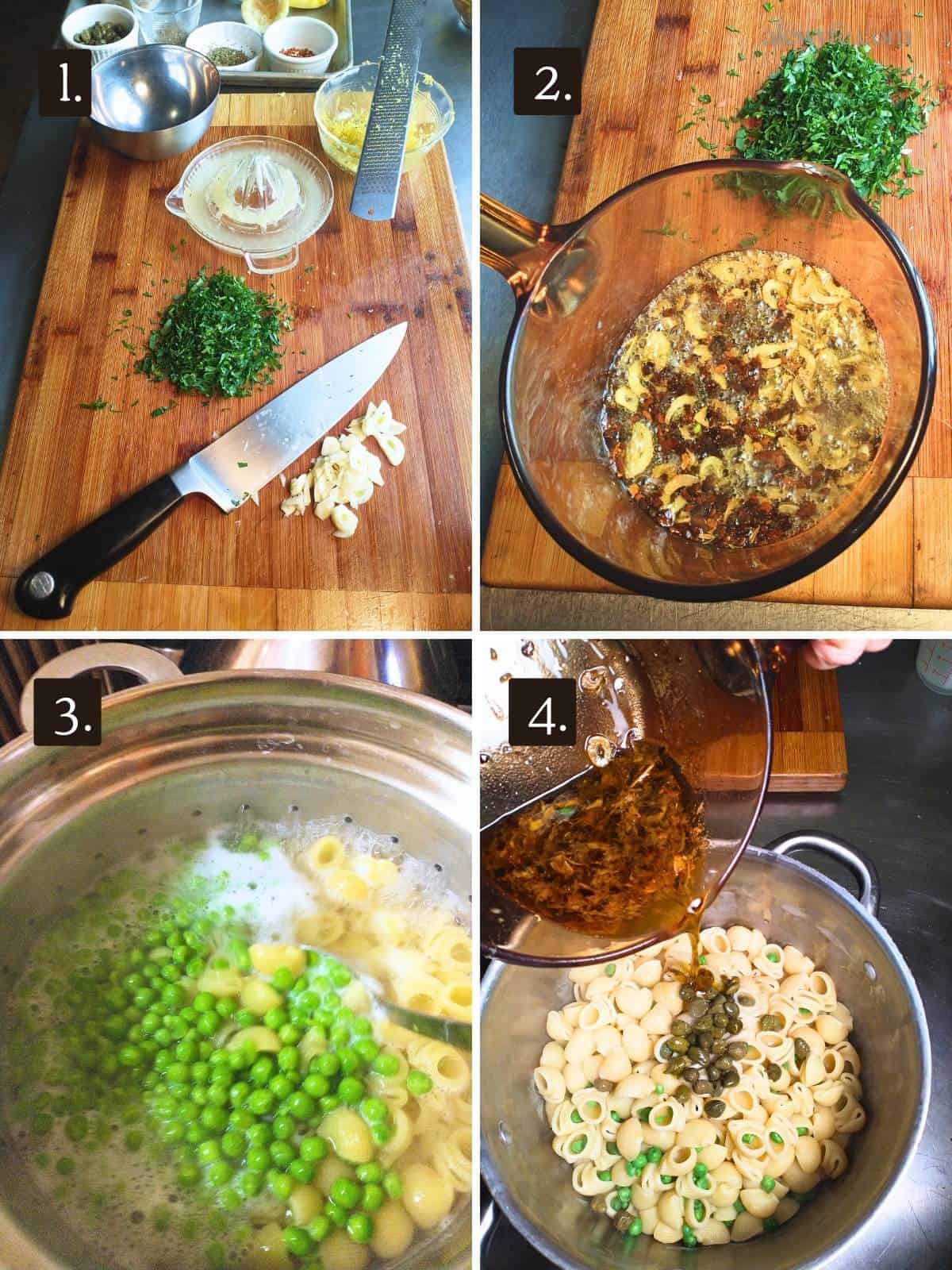
step one:
- Bring a large pot of lightly salted water to a boil over high heat.
- Peel and chop your fresh garlic cloves and get out your other ingredients. I like to thinly slice the whole garlic cloves for this dish, but you can also chop or mince them.
- Zest and juice the lemon (or mince the preserved/salted lemon).
- Mince the parsley or other fresh herbs.
step two:
- Add the olive oil, red pepper flakes, dried herbs, lemon zest (if you’re using it), and the garlic to the oil.
- Heat over medium-high heat just until the garlic is fragrant and beginning take on the tiniest bit of color.
- Remove the pot from the heat. It will continue to cook, so make sure you don’t burn your garlic!
- If the pan gets too hot and you need to stop the cooking quickly, you can quickly add the lemon juice and capers to the oil at this point to cool it down after removing it from the heat.
step three:
- Cook your pasta al dente (follow the directions from your pasta manufacturer since cook times vary).
- If you are using frozen peas, add them during the last 2-3 minutes of cooking time for the pasta. Dried peas should go in at the beginning so that they have time to rehydrate. Canned peas should go in the compost… I’m kidding! Mostly. :)
- Test a noodle, and drain the pasta when it is cooked through but still has a bit of a chewy bite to it. It will cook a little bit more when you are making the sauce.
- Make sure you save and set aside at least a cup of the pasta cooking water to make your sauce!
step four:
- Return the cooked pasta back to the pot. To the pasta pot, over low heat, add the infused oil, the fresh herbs, lemon juice or minced preserved lemon, and capers.
- Add about half of the pasta water. Stir and toss the pasta to coat.
- Add the can of tuna along with the oil, and the Parmesan cheese.
- Break the tuna up gently as you mix the pasta. I like to leave large chunks, but you can also mix it in completely. It’s up to you!
- Add additional splashes of pasta water if needed to bring the sauce together until it coats the pasta completely.
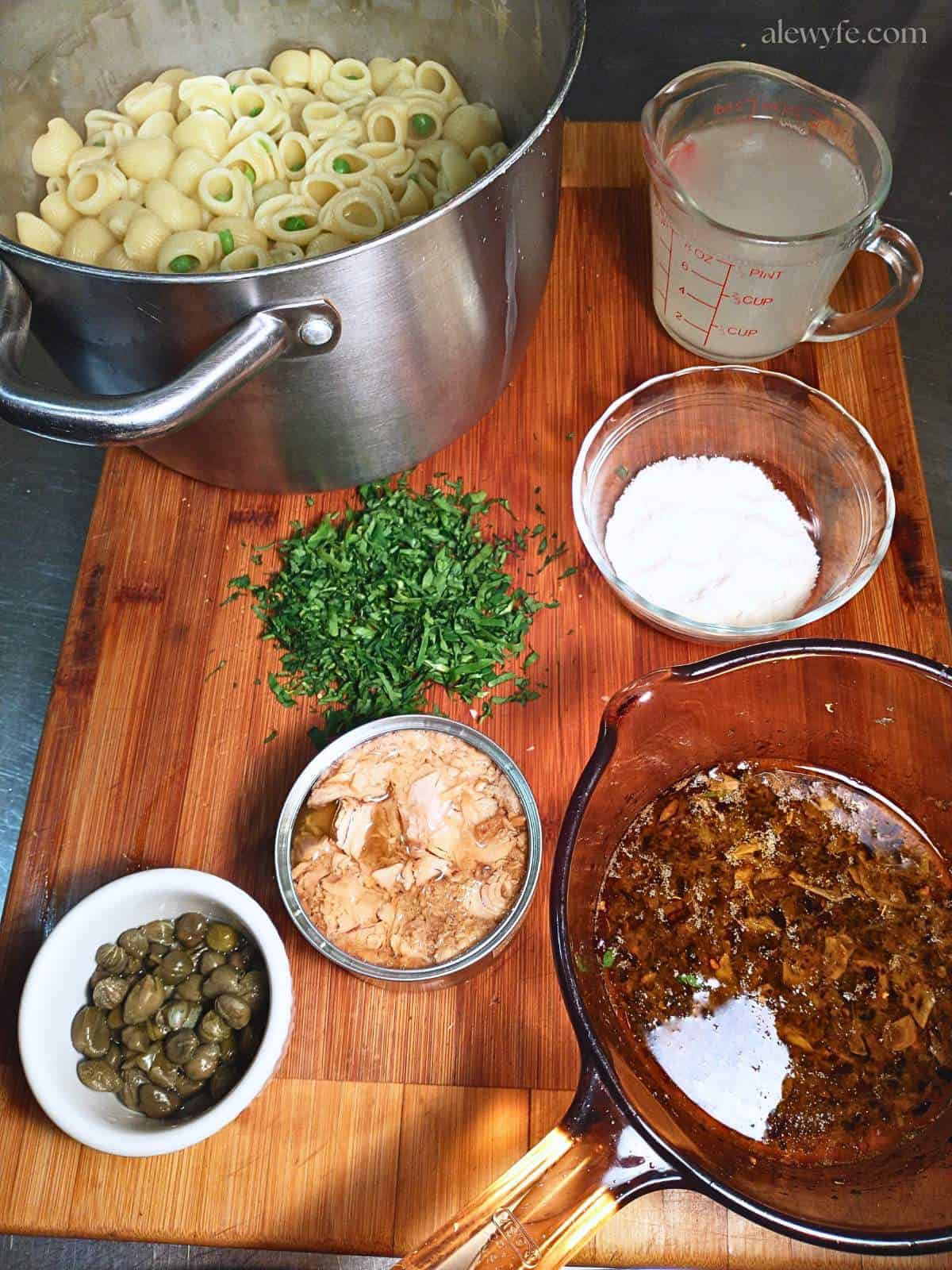
Storage & Serving Ideas
Like many pasta dishes, this tuna pasta recipe is best when hot and freshly prepared. You can refrigerate leftovers and enjoy them up to three days later, either rewarmed until heated through. You can also eat leftovers as a cold pasta salad. I don’t recommend freezing this dish.
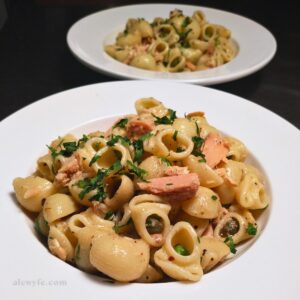
Spicy Tuna Pasta with Garlic, Herbs, and Peas
Ingredients
- 16 oz lumache, medium shells, or pasta of your choice (see recipe notes for recommended shapes)
- 1 ½ cups frozen peas (can substitute ⅔ cup dehydrated peas)
Infused Oil:
- ⅓ cup olive oil
- 3 cloves fresh garlic, thinly sliced or minced (or to taste)
- 1 tbsp grated lemon zest (or add 1 tbsp minced preserved lemon to pan sauce step)
- 1 tsp red pepper flakes (or to taste)
- 1 tsp dried oregano, marjoram, or Italian herb blend (sub fresh herbs if available)
- ¼ tsp freshly ground black pepper (or to taste)
Pan Sauce
- 1 can tuna packed in olive oil
- 1 cup reserved pasta water (start with ½ cup, adding more if needed)
- ¼ cup grated Parmesan
- 3 tbsp fresh parsley (can sub fresh oregano, basil, or chives, but reduce the amount as these have a stronger flavor)
- 3 tbsp fresh lemon juice
- 2-3 tbsp brined capers (optional)
- tt salt and freshly ground black pepper (to taste)
Instructions
- Bring a large pot of lightly salted water to a boil over high heat.
- Peel and chop your fresh garlic cloves and get out your other ingredients. I like to thinly slice the whole garlic cloves for this dish, but you can also chop or mince them.
- Add the olive oil, red pepper flakes, dried herbs, lemon zest (if you’re using it), and the garlic to the oil and heat over medium-high heat just until the garlic is fragrant and beginning take on the tiniest bit of color. Remove the pot from the heat. It will continue to cook, so make sure you don’t burn your garlic!
- Cook your pasta al dente (follow the directions from your pasta manufacturer since cook times vary). Add the peas during the last 2-3 minutes of cooking time for the pasta.
- Drain the pasta and peas, saving at least one cup of the pasta water. Return the pasta & peas to the cooking pot, and set the reserved pasta water aside.
- To the pasta pot, over low heat, add the infused oil, the fresh herbs, lemon juice or minced preserved lemon, and capers, along with about half the pasta water. Stir and toss the pasta to coat.
- Add the can of tuna along with the oil, and the Parmesan cheese. Break the tuna up gently as you mix the pasta. I like to leave large chunks, but you can also mix it in completely. Add additional pasta water if needed to bring the sauce together.
- This dish is best served immediately, or keep hot and refrigerate any leftovers promptly.
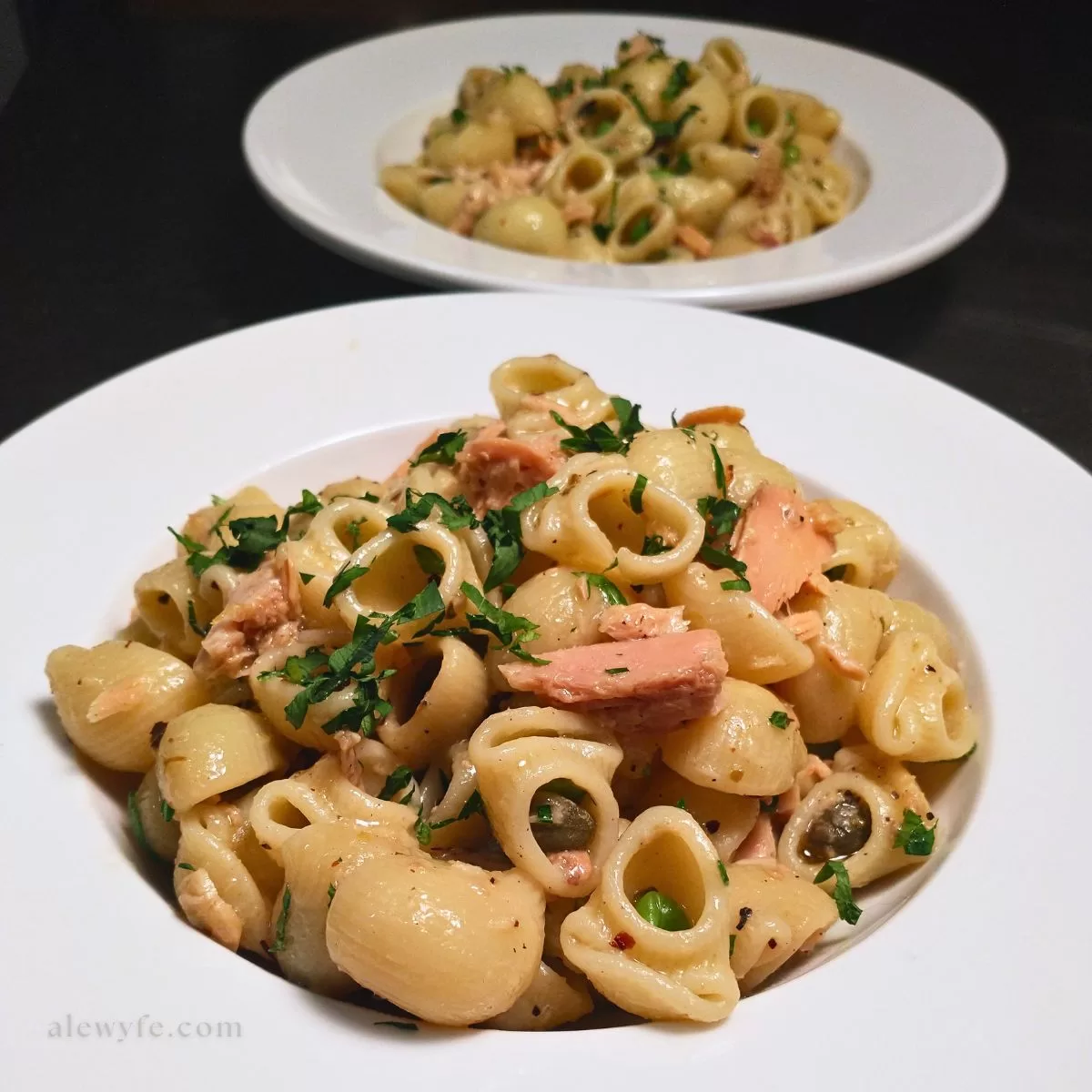
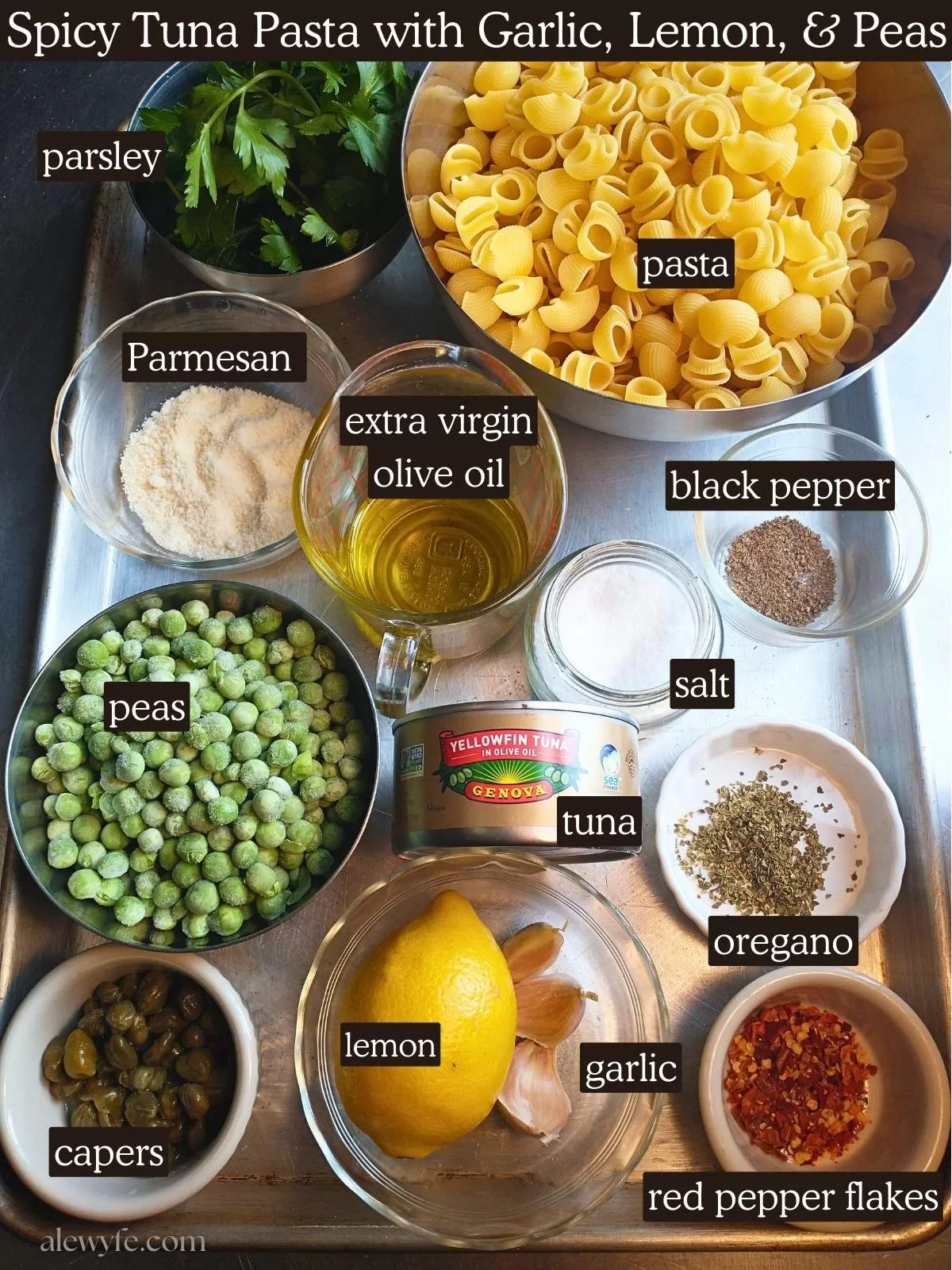
The most amazing recipe ever!!! Very quick and incredibly delicious!!!!
So delicious and came together quickly! I have never made a recipe with capers but I definitely want to more frequently!!!
Thanks Bianca… I’m glad you enjoyed it! :)